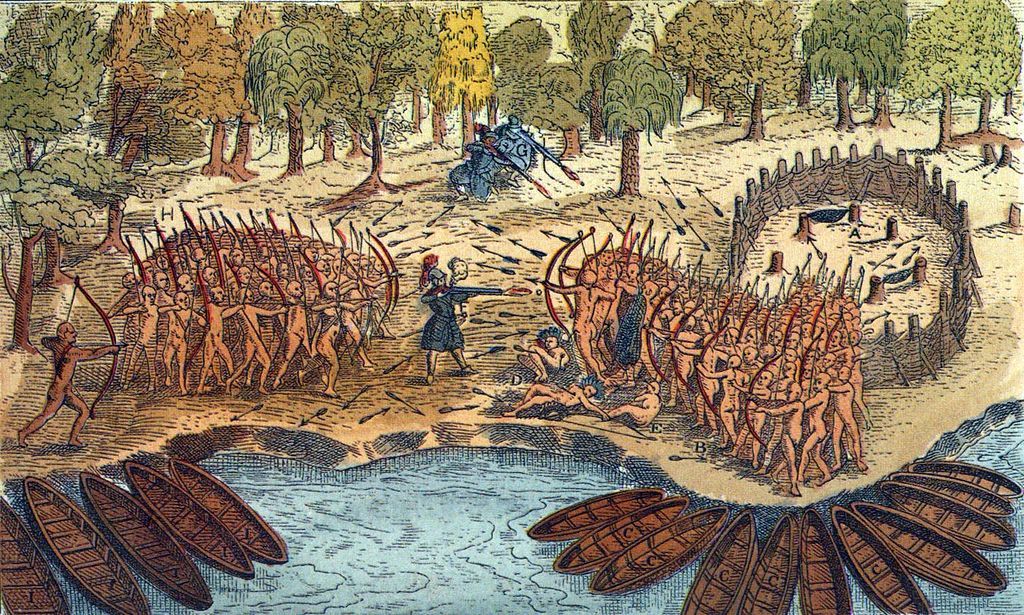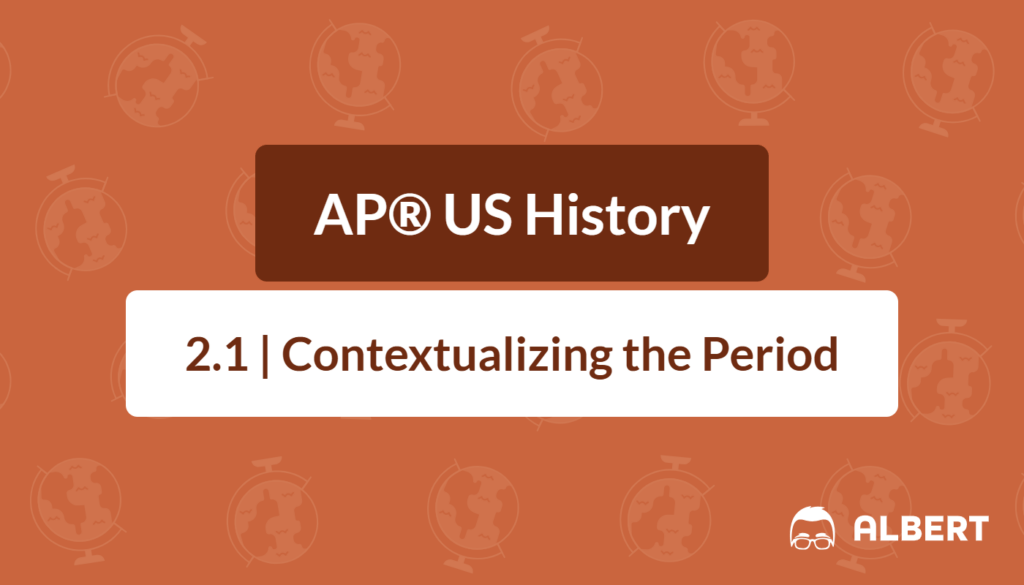What We Review
Contextualizing Period 2: Colonization and Competition in North America (1607-1754)
Introduction
Period 2 in AP® US History covers the years 1607 to 1754. This era includes the beginning and growth of European colonies in North America and the complex interactions across cultures and territories. Through contextualization, students can better understand how these years saw intense competition among European powers and with Native American groups for land, resources, and influence.
Understanding this context is key for the APUSH exam. This period was shaped by different colonization patterns, regional differences, and constant struggles for power and resources. In this article, you will learn how colonization took many forms, why certain regions developed distinct cultures, and how rivalry helped shape the continent.
European Colonization and Migration Patterns
During Period 2, four main European powers settled in North America: the Spanish, French, Dutch, and British. Each came with different goals, which affected how they set up colonies and interacted with Native Americans.
- Spanish: Focused on extracting wealth (mainly gold and silver), spreading Christianity, and controlling large populations of Native people.
- French: Sought to profit from trade, especially in furs, and built alliances with Native tribes.
- Dutch: Concentrated on trade and building a profitable port (New Amsterdam, now New York City).
- British: Wanted land for settlement, entrepreneurship, and religious freedom, drawing large numbers of settlers.
These distinct goals led to different labor systems, social structures, and relationships with Native Americans.
Spanish Missions vs. British Plantations: A Colonial Comparison
Spain and Britain had very different approaches to colonization in the Americas, especially in terms of goals, labor systems, and relationships with Native peoples.
- Goals:
- Spanish: Focused on spreading Christianity through missions and extracting natural resources.
- British (Southern Colonies): Aimed to generate wealth by growing cash crops like tobacco, rice, and indigo for export.
- Labor Systems:
- Spanish: Used the encomienda system, which forced Native Americans to work in fields, mines, or missions.
- British: Initially relied on indentured servants, then shifted to enslaved Africans as the main labor force on plantations.
- Native Relations:
- Spanish: Tried to convert Native peoples and incorporate them into colonial society under strict control.
- British: Generally displaced Native populations, taking over land for farming and settlement with little effort at integration.
Check Your Understanding
Why did the French maintain better relations with Native Americans than the British or Spanish?
French colonists engaged in small-scale fur trading and depended on Native Americans for knowledge of the land, trade networks, and animal trapping. Instead of pushing Natives off their land or forcing conversions, the French often formed alliances, intermarried, and learned Indigenous languages, resulting in more cooperative and respectful relationships.
III. Development of Early British Colonies along the Atlantic Coast
The early British colonies developed into different regions, influenced by environment, economy, and the people who lived there.
Regional Differences
- New England Colonies (e.g., Massachusetts): Cold climate, rocky soil. Settlers came for religious freedom. Small farms, fishing, shipbuilding, and trade.
- Chesapeake Colonies (e.g., Virginia): Warm climate, fertile soil. Grew tobacco on large plantations. Many indentured servants, later enslaved Africans.
- Southern Colonies (e.g., Carolina): Hot and humid, good for rice and indigo. Built huge plantations, relied even more on enslaved labor.
Geography and climate played a big role in shaping each region’s economy and society.
Example: Why New England Colonies Focused on Trade and Fishing
The New England colonies developed differently from southern regions due to their geography, economy, and social structure.
- Geography: The land in New England was rocky with thin soil and a short growing season, making large-scale farming difficult.
- Economy: With limited farming opportunities, colonists turned to the sea. Fishing, shipbuilding, and trade became key industries.
- Society: New England communities were small and close-knit. They often organized around town meetings and valued local, self-governed leadership.
Check Your Understanding
How did labor systems differ between Virginia (Chesapeake) and Massachusetts (New England)?
- Virginia relied on indentured servants and, later, enslaved Africans to work large cash crop plantations, especially tobacco.
- Massachusetts, by contrast, had small family-run farms that required less labor, so there was less reliance on servants or slavery.
Competition over Resources: European Rivalries and Native Relations
European countries and Native American tribes competed for land, trade, and resources. Sometimes, alliances formed; other times, conflicts broke out.
Key resources included fur, land, and trade routes. Both Natives and Europeans used alliances—and sometimes war—to protect their interests and expand their influence.
Major Examples
- King Philip’s War (1675-1676): Major Native uprising against English settlers in New England.
- Beaver Wars: Conflicts between Iroquois (backed by the British) and French-supported tribes centered on the fur trade.
Impact of the Beaver Wars
The Beaver Wars were a series of conflicts in the 17th century that reshaped power dynamics in the Northeast and Great Lakes regions of North America.
- Key groups involved:
- The Iroquois Confederacy, supported by the British.
- French-allied Algonquian-speaking tribes, including the Huron and Ottawa.
- Cause of conflict:
Both sides competed for control over the lucrative fur trade with European powers. Access to European goods—especially guns—gave military and economic advantages. - Major outcomes:
- The Iroquois expanded their territory and severely weakened rival tribes allied with the French.
- French fur trade networks were disrupted, reducing their influence in the region.
- British colonial power grew as their alliance with the Iroquois strengthened.
These wars not only altered Indigenous alliances but also foreshadowed future tensions between European empires in North America.

Exchanges and Political Evolution in British North America
The British colonies were not cut off from Europe; they actively traded goods and ideas with Britain and other colonies. These exchanges had important effects:
- Economic: Transatlantic trade (part of the triangular trade) brought prosperity and new goods.
- Religious/Philosophical: Ideas about rights and government (like those from the Enlightenment) spread across the Atlantic.
- Political: Colonists developed new identities and began to question British rule.
Increasing connectedness sometimes led to pride in being British, but over time, also sparked early resistance.
The Atlantic Slave Trade and Slavery in the English Colonies
Slavery became central to the economy of many British colonies. Enslaved Africans arrived mainly through the transatlantic slave trade.
Regional Differences in Slavery
- Chesapeake (Virginia and Maryland): Grew tobacco, required big labor force. At first, used indentured servants, but shifted to African slaves.
- Deep South (Georgia, South Carolina): Plantations grew rice and indigo; climate suited large-scale slavery.
- Northern Colonies: Smaller farms, less demand for enslaved labor, but still participated in slave trade.
Example: How Tobacco Shaped Slavery in the Chesapeake
The rise of tobacco as a cash crop in the Chesapeake region—especially in Virginia and Maryland—had a powerful impact on the development of labor systems, including the growth of slavery.
- Labor demand: Tobacco cultivation was extremely labor-intensive, requiring a steady and large workforce.
- Early labor source: At first, colonists relied on indentured servants from Europe—typically poor workers who agreed to work for several years in exchange for passage to the colonies.
- Shift to slavery:
- As the supply of willing indentured servants declined, planters sought a more permanent labor solution.
- Enslaved Africans began to replace indentured servants, leading to a race-based system of slavery that became central to the Chesapeake economy.
Check Your Understanding
Why did slavery become more common in the Chesapeake than in New England?
The Chesapeake’s economy was built around labor-intensive crops like tobacco, which required a large, reliable labor force. New England, on the other hand, had smaller family farms and a cooler climate, making large-scale plantation slavery less common or necessary.
VII. Quick Reference Chart: Key Vocabulary and Definitions
| Term | Definition |
| Encomienda System | Spanish labor system using Native Americans for farming and mining |
| Indentured Servant | Person who worked for a set time (usually 4-7 years) in exchange for passage to America |
| Cash Crop | A crop grown for sale rather than personal use (e.g., tobacco, rice) |
| Triangular Trade | Three-way exchange of goods and people between Europe, Africa, and the Americas |
| Plantations | Large farms using forced labor, especially in the South |
| Mercantilism | Economic theory where colonies exist to benefit the mother country by supplying raw materials |
| King Philip’s War | 1675-76 conflict between New England colonists and Native Americans led by Metacom |
| Beaver Wars | Series of conflicts (1600s) over control of the fur trade in the Great Lakes region |
| Middle Passage | Forced voyage of enslaved Africans across the Atlantic to the Americas |
| Atlantic Slave Trade | The buying, transporting, and selling of Africans for work in the Americas |
| Enlightenment | 18th-century movement emphasizing reason, science, and individual rights |
Conclusion
Period 2 (1607-1754) was shaped by many different groups vying for power, land, and resources. European powers and Native American tribes formed alliances and fought for control. Each colony grew in unique ways based on environment, economy, and migration patterns.
Understanding these big themes will not only help you on the APUSH exam, but it will also help you make sense of the social and political roots of the United States. Reviewing the examples and vocabulary is a great way to reinforce this important content. Keep these key ideas in mind as you move into the next periods of US History!
Sharpen Your Skills for AP® US History
Are you preparing for the AP® US History test? We’ve got you covered! Try our review articles designed to help you confidently tackle real-world AP® US History problems. You’ll find everything you need to succeed, from quick tips to detailed strategies. Start exploring now!
- AP® US History: 2.2 Review
- AP® US History: 2.3 Review
- AP® US History: 2.4 Review
Need help preparing for your AP® US History exam?
Albert has hundreds of AP® US History practice questions, free response, and full-length practice tests to try out.








